
An intensifying climate and ongoing impacts of the shift to remote work will transform Arlington over the next 25 years, experts say.
At the same time, the county’s workforce will need to become more nimble to keep up with changes driven by artificial intelligence.
Speakers made these predictions on Monday during a panel that kicked off a year-long discussion of what Arlington should look like two-and-a-half decades from now, called the Arlington 2050 Initiative.
Arlington County Board Chair Libby Garvey, who moderated the event, said the county will use community input to produce two or three visions to guide later decisions.
“For now, we’re just trying to get as many views as we can, as possible, to begin to form those alternate visions of what our future should be,” Garvey said.
At the end of the evening, a crowd of about 150 attendees filled out postcards imagining that they were describing Arlington in the year 2050. Common themes included more green spaces, expanded public transit and the erasure of racial and economic disparities.
“Diverse thought and opinions are prioritized in order to make Arlington a place where people can live comfortably, and at times during difficult conversations, uncomfortably, in order to progress our county,” said a 16-year-old representative from the Teen Network Board, reading aloud from a postcard.
The climate in 2050
In terms of the climate, Arlington’s 2050 forecast calls for hotter summers and more intense precipitation.
In the 1800s, Arlington used to experience about 20 days each summer above 90 degrees, said panelist Jason Samenow, a meteorologist and weather journalist at the Washington Post. These days, it’s more like 40.
Between 2041 and 2070, Arlington is expected to average 65 days each year above 90 degrees — and that’s based on an optimistic model. More aggressive scenarios, he said, call for even more serious impacts.
“It just means more suffering, especially for vulnerable populations, for people who are poor, the homeless,” Samenow said. “On hot summer nights, they can’t cool off. That increases heat-related illness, heat-related mortality.”
A warming climate disparately impacts urban areas such as Arlington, which tend to have lots of concrete and asphalt, he said. These surfaces absorb heat and radiate it back into the environment, making them hotter than more rural areas. The county can combat these effects by planting more trees and investing in surfaces that reflect heat instead of absorbing it.
In addition to heatwaves, heavy rainstorms are expected to take a toll and the meteorologist warned of more flash flooding such as the severe floods Arlington saw in 2019.
He urged the county to find ways to reroute traffic and redirect floodwaters during torrential rain.
“I think we have to start thinking real mitigation, from the perspective of how an engineer sees mitigation,” Samenow said. “That means redesigning how we live, redesigning how we work, redesigning how we play.”
Adapting to remote work
Another challenge that Arlington faces is people leaving.
Even before the pandemic, many young urban professionals across the country were seeking less expensive places to live, said Hamilton Lombard, a demographer at the University of Virginia Weldon Cooper Center for Public Service. Arlington was not immune from this trend, exacerbated by the shift to remote work, the consequences of which are still playing out.
Remote workers continue to leave Arlington en masse, Lombard said, noting that last year, people moved out of Arlington “on a scale comparable with 2020 and 2021.”
If many workers can live anywhere, the county needs to figure out why people should choose to remain here.
“There’s a lot of rural counties in Virginia that are very happy to compete with Arlington,” the demographer said. “I think five years ago, people would have laughed at that idea. But they’re not. They’re very serious about it now.”
As Arlington continues to seek solutions to the effects of remote work, Lombard said the county should consider just how much it has adapted and changed at other points in recent history, such as its “smart growth” along Metro corridors.
“Arlington has shown in the past that it has the capacity to make some serious adaptations and changes,” he said. “It did this with Metro. I think in the next couple decades, [Arlington is] going to have to make changes on a scale that has been successful in the past.”
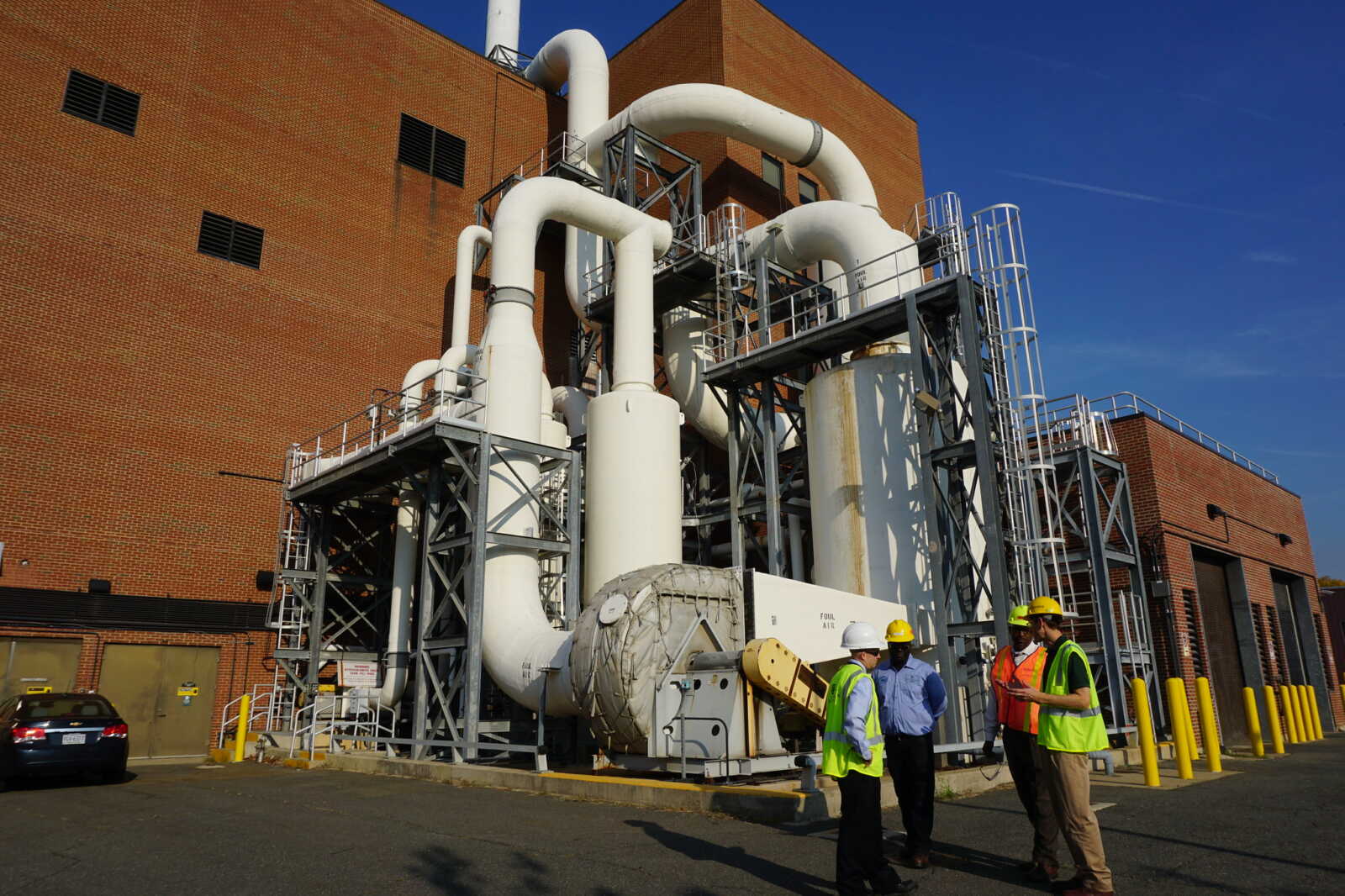
More dirty details have emerged in the county’s $175 million plan to start using sewage for consumer-friendly fertilizer and renewable energy.
The first step is a $32 million budget authorization, set to be considered by the Arlington County Board this Saturday, to begin new upgrades the Arlington County Water Pollution Control Plant.
The county says the upgrades are overdue. The plant currently relies on solids handling processes that date back to the 1950s through 1990s. Irritating fumes sometimes force staff to use respirators, according to a county report.
“The facilities that thicken, store, dewater, and stabilize the residuals are beyond their useful life and break down frequently,” the report says.
All that is supposed to change.
Better sludge storage tanks, improved odor control systems and anaerobic digesters all play a role in the county’s plans to turn sewage into fertilizer and harness the natural gas byproduct for energy. Additionally, while Arlington sewage byproducts already fertilize agricultural land elsewhere in the state, better equipment will make it possible to either sell the county’s biosolids as a retail product or make them available to residents.
“The upgraded processes will produce a higher quality biosolids product as well as renewable natural gas, which will reduce the County’s dependence on fossil fuels,” according to the report.
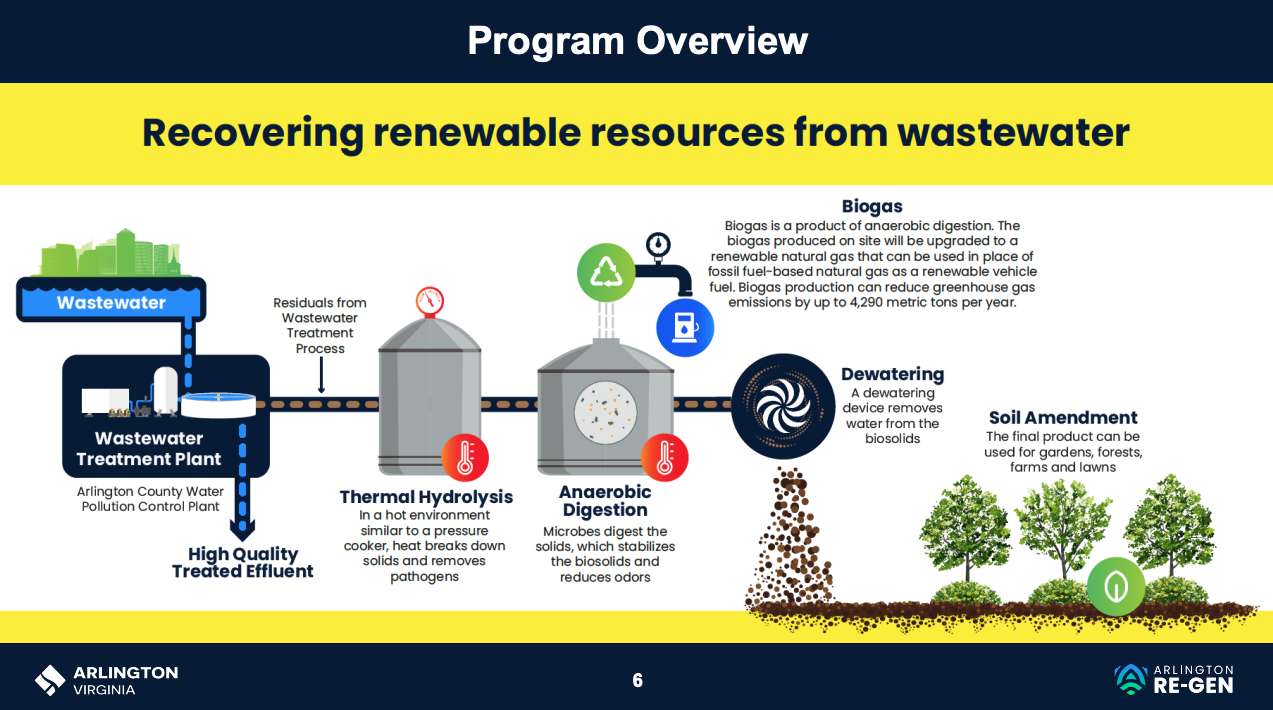
Arlington wouldn’t be the first municipality to sell its processed sewage to consumers. Anyone who enriches their garden or lawn using the fertilizer brand Milorganite does so using treated sewage from Milwaukee.
The county is budgeting $175 million for all the upgrades and changes, plus an additional $23 million in soft costs, bringing the total budget to nearly $200 million.
The bulk of the funding comes out of $510 million in bonds that Arlington voters approved in 2022. This project is part of a host of initiatives, upgrades and maintenance projects that make up the county’s 2023-32 Capital Improvement Plan.
Staff have discussed the project with community members since 2015, the county report notes. People near the Water Pollution Control Plant, near the Arlington-Alexandria border and west of Route 1, have raised concerns about noise and vibrations that construction might cause, as well as possible emissions.
The county has pledged to use techniques to minimize impacts on the neighborhood when possible, per the report. Following stakeholder concerns, the county also nixed plans to burn the biogas byproduct to generate electricity onsite. It will instead clean and inject the resulting natural gas directly into the Washington Gas pipeline.
Photo via Arlington Dept. of Environmental Services/Flickr

Arlington’s office vacancy rate remains high but may be stabilizing after an initial, sharp increase due to Covid remote work policies.
As of the fourth quarter of 2023, the countywide office vacancy rate stands at 24.4%, according to a new report from commercial real estate company Colliers.
Since 2020, Arlington’s overall vacancy rate has risen 4.3% points, per the report, prompted by the pandemic-era shift to remote work and in defiance of return-to-office efforts. The county saw a 3-percentage-point jump between 2020 and 2021 followed by a more modest 1-percentage-point increase over the last year.
“The big story last year was the delivery of Amazon’s HQ2 which drove absorption earlier in the year,” Colliers Research Manager Miles Rodnan tells ARLnow. “Sublet space across the D.C. region has leveled off, which has helped slow down vacancy increases.”
“Additionally, as companies continue to settle into their return-to-office/hybrid policies, the decisions to offload space have been made in many instances,” he continued. “As leases continue to expire, there will be downsizes, but the rate should taper off.”
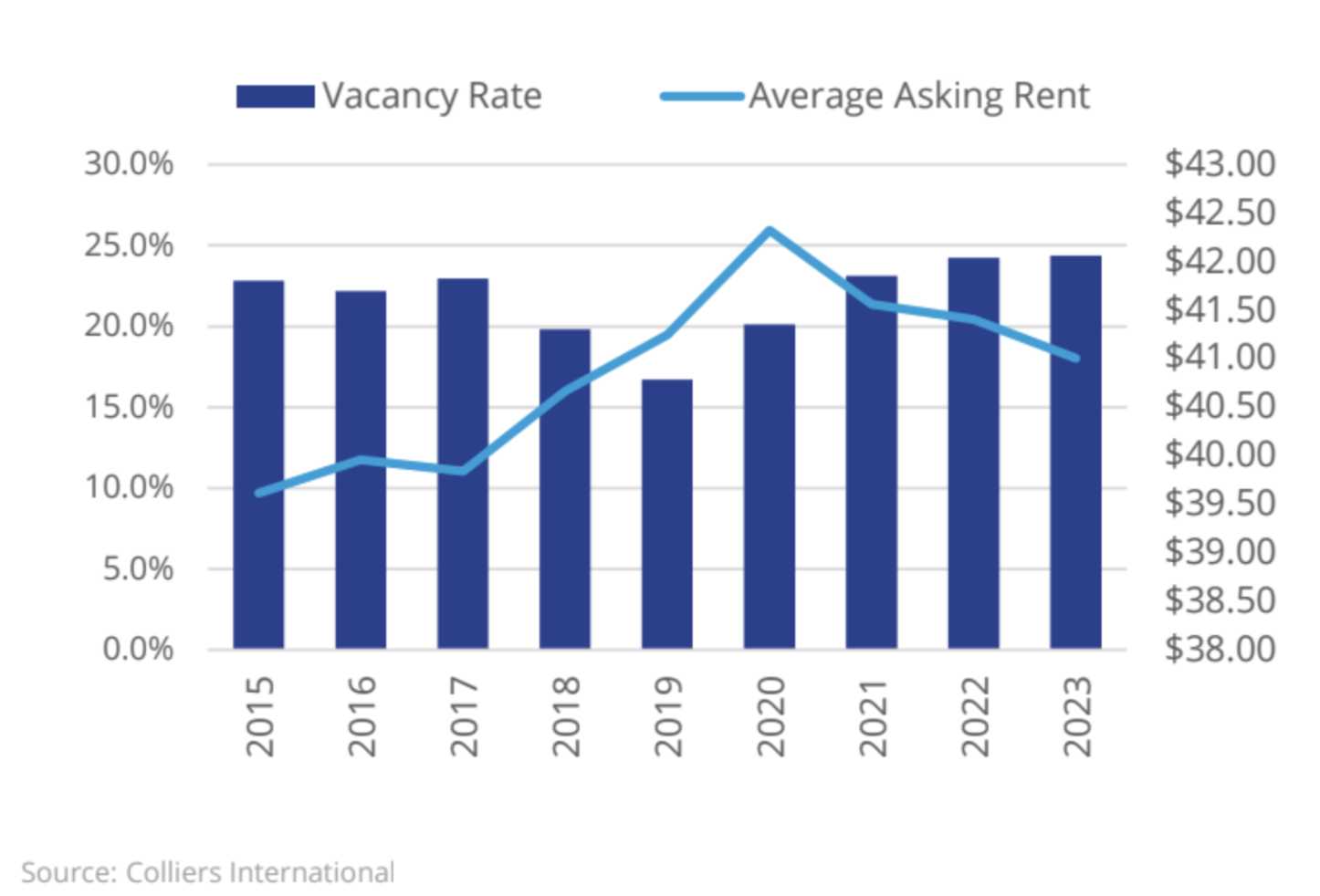
(Arlington County also tracks its vacancy rate and, notably, it reported a rate hovering around 21.5-22% this fall. This discrepancy may be because the county and Colliers have different numbers for total office buildings and rentable square footage. Graphs tracking rates over time, from the county and Colliers, have similar trend lines.)
At the end of 2023, the Colliers report says vacancy rate was slightly higher for the Rosslyn-Ballston corridor, at nearly 25%, than for National Landing — Pentagon City, Crystal City and Potomac Yard — at 24%.
While the difference is marginal, the rate is trending down in National Landing dropping 0.7% point over 2023, while the rate increased 0.8% point on the R-B corridor, the report said.
Compared to National Landing, where all the new office construction was tied to Amazon, the R-B corridor saw more speculative office projects: 3901 Fairfax Drive in Virginia Square, slated for delivery next year, as well as George Mason University’s FUSE at Mason Square building, which will house university programs in addition to private office space.
Overall, however, these projects contribute less than a million square feet of leasable office space. Rodnan says this could be a saving grace, given predictions that vacancy rates will continue to rise.
“A breath of fresh air comes from the restrained construction pipeline, which will hopefully allow vacancy rates to stabilize in the region as negative absorption is still anticipated in the near future,” he said.
Generally, newer office buildings — which real estate analysts dub “Class A” — are attracting tenants who are willing to pay upwards of $2 more per square foot to get out of dated office stock, or so-called “Class B/C” buildings.
This is a trend playing out across the region, Rodnan said, not attributing the submarket-level upticks to any tenants in particular.
Amid the well-established “flight to quality,” Arlington County is working on several initiatives to make it easier to reposition these obsolete buildings from which people are moving.
“The work is cut out for us: zoning needs to become reasonably more flexible and less burdensome,” Arlington County Board Vice-Chair Takis Karantonis said during his New Year remarks this week. “We need to be innovative and courageous in repositioning and reusing obsolete buildings.”
County Board member Matt de Ferranti spelled out what this office vacancy rate means for the county budget.
“We depend on our office vacancy rate, which leads to a lower tax rate than our surrounding localities in northern Northern Virginia,” he said, noting that commercial real estate comprises a greater percentage of Arlington’s budget than that of neighbors.
Either this month or next, Arlington County will learn the extent of the impact of decreased office property values on the expected budget deficit, which is preliminarily projected around $20-$40 million.
“That will be sobering news, or perhaps hopeful news,” de Ferranti said.
Through April, the 2024-25 budget process will address the ongoing challenge of high office vacancies.
“Why is this budget more difficult than our last? Haven’t we known about the work-from-home paradigm shift for two years?” said de Ferranti. “Well, we have, but the office assessment process and that market is based on 5-, 10- and 15-year leases. So this year, we’re seeing the reality come home to us.”
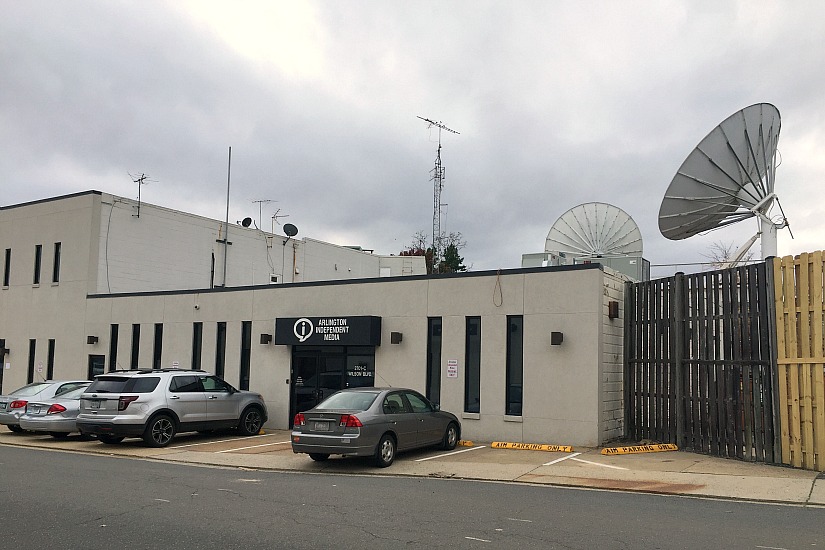
(Updated at 12:20 a.m. on 12/7/23) After a 2-year search for new digs, Arlington Independent Media is on the cusp of moving from its long-time headquarters in Clarendon.
Next week, Arlington’s public access TV channel, community radio station and media training provider intends to sign a lease for space in Courthouse Plaza, says its CEO Whytni Kernodle. The building is owned by JBG Smith and home to Arlington County headquarters.
The cash-strapped organization is having to look outside its coffers to leave before its Dec. 31 deadline. The organization disclosed it had $31,000 in cash on hand during its November meeting, according to Lynn Borton, a former producer with AIM who was in attendance.
Kernodle requested $350,000 in funds that Comcast sets aside for expenses by public institutions, Arlington Public Schools and the county government. She also intends to fundraise another $25,000.
Once settled in Courthouse, Kernodle envisions an “On Air!” sign attracting passers-by to come and listen to music and watch AIM produce live shows. Next year, she wants to add public speaking events.
“The really great community media organizations are out in the community without waiting for people to come to their location,” she said. “We’re coming to the community as opposed to expecting the community to come to us.”
AIM will retain its rent-free second location in a county-owned building in Green Valley, for which it pays an “affordable license fee,” according to the county.
Kernodle says it was not a viable headquarters because it was too small and too far from the broadcast tower AIM uses in Courthouse for live shows. She also did not want to give up a North Arlington presence.
The move comes as the organization faces pressure to clarify its finances and rely more on fundraising, membership fees and advertising, and less on county funding, for its operational expenses.
AIM also faces existential pressures from consumers choosing streaming over cable, as fewer cable subscriptions means less funding for Public, Educational, and Governmental (PEG) Access Channels — and fewer viewers.
Streaming, along with better technology and the dominance of social media, can also weaken the value of AIM’s core offerings — professional-grade equipment, studios and training for content creators — says Rodger Smith, a senior instructor in the George Mason University Department of Communication.
“Why go to AIM when I can be in my house and I can create a podcast that still sounds broadcast quality or I can produce video,” says Smith, who is also the faculty advisor for WGMU, the campus online radio station. “They have to offer a service that [people] can’t find anyplace else.”
Rocky finances and a forthcoming governance document
AIM will be leaving a building where the rent almost sank it financially, but its woes are not behind it.
When AIM lost free rent at 2701 Wilson Blvd as part of a 2016 local cable franchise agreement, it racked up $80,000 in debts and nearly went under, even after the county paid its market-rate rent for several months, says Borton.
While serving as AIM’s president, she got collections officers to stop calling in 2019 and negotiated a lower rent. The organization has known it needed to move since 2021, when the new owner of 2701 Wilson Blvd opened the Beyond Hello dispensary next door, with plans to take over AIM’s space, Borton said.
All this time, the county tried to wean AIM from county support, proposing, then lessening, cuts after outcry from AIM staff and listeners.
The organization continues to face financial transparency challenges, as it is behind on its Form 990s. The IRS makes public these nonprofit tax forms so people can gauge an organization’s financial health.

Unionized trade workers have tentatively negotiated with Arlington County for wage increases and safety protections for the next four years.
Predicting a budget gap in the 2025 budget, however, the county says it will have to raise taxes or make budget cuts to pay for these provisions, according to a fiscal analysis the Arlington County Board is set to hear about during its Saturday meeting.
If the county opts to raise taxes, residents could see their bill go up $5-9 on average. This would be in addition to a predicted 1.8% increase in real estate values, which works out to an average increase of $146. For reference, property values increased 4.5% for 2023.
Higher taxes or budget cuts would cover most of the increases. The rest would be covered with a nearly $3 utility fee increase and a new stormwater utility fee that residents will begin paying in 2024 in lieu of the current sanitary district tax.
Arlington County held steady residential real estate taxes this year, at $1.013 for every $100 in assessed value. Arlington County Board Chair Christian Dorsey has foreshadowed this could go up next year, however. To cover the tentative wage increases, county officials are suggesting raising the rate to $1.0136 or $1.0141.
County government and the Service, Labor, And Trades (SLT) Bargaining Unit have tentatively agreed to 55 provisions, of which only a handful, including higher wages, have financial impacts, according to the county. Another would ensure employees do not end up getting less weekly pay after responding to emergencies.
“Crews work on emergency situations, like water main breaks, often outside of the normal workday schedule and can be scheduled outside of their normal hours to complete such work,” Director of Management and Finance Maria Meredith says. “In cases where this occurs and impacts the normal work schedule, this premium ensures that staff will receive at least 40 hours of pay in the week if such a situation arises.”
SLT union members also requested more subsidized parking for unionized employees and the ability to do union-related work without forfeiting docked pay or paid time off.
This works out to about $1 million in additional expense in the 2025 fiscal year budget: $511,000 from the General Fund, $401,000 from the Utility Fund and $94,000 to other funds. Budgets through the 2028 fiscal year will be affected, too, and the county is now looking for funding sources.
“Given the projected budget gap in the FY 2025 General Fund budget, the $0.5 million FY 2025 impact of this potential agreement cannot be absorbed within estimated revenue growth without taking service reductions, increasing taxes, or a combination of these options,” per a county report.
The following chart shows two scenarios for how the tax bill could go up to cover the tentative agreement:

If the Board opts not to raise taxes, it could pay for the $511,000 General Fund obligation with across-the-board cuts to the tune of 0.1% or eliminating about four full-time employees who earn $125,000 each, including benefits.
Any reductions “would be considered with input and engagement from the community,” the county says.
“In prior years, similar FTE reductions have been taken across a variety of agencies, including planning, public safety, human services and environmental services,” the county says.
Arlington County proposes a modest increase to the water-sewer rate to cover the $401,000 in increased costs coming from the utility fund.
On average, residential customers would see their water bill go up $2.85 per year. A $0.20 per thousand gallon rate increase to cover expenses to the Stormwater Utility Fund will be included in next year’s new stormwater utility fee.
In December, the County Board “can resolve to make a good faith commitment to appropriate funding to meet the obligations under the tentative agreement,” the report says. If the Board does not, either the County Manager or the union may reopen negotiations.

Virginia Railway Express is considering introducing Saturday service and making fares free for children.
The former would result in three round-trip trains on the lines connecting Arlington, from its Crystal City station, to Manassas and Fredericksburg. Service would head northbound in the morning and southbound in the afternoons and evenings.
Adding Saturday service is part of a bid to increase ridership on the rail by moving beyond mostly serving commuters from ex-urban counties headed to D.C.’s urban core. Average daily ridership has surpassed 6,000 and is ticking up but is far from the agency’s 2024 goal of 10,000 average daily riders. Still, looking from January 2022 to this January, VRE saw a whopping 114% growth, which Greater Greater Washington reports trumps all other commuter or regional rail systems.
“We’re moving into an all-week service for our trains,” County Board member Takis Karantonis said during a meeting last Tuesday. “Like every other major, mature metropolitan area, this kind of train service should be growing and graduating out of its mere commuter function into a real regional connector.”
Local transit advocacy group, Sustainable Mobility for Arlington County, or SusMo, also celebrates the changes for making the train more useful to Arlingtonians. County residents make up such a small fraction of riders that they are lumped in with Alexandrians and “other” riders in VRE ridership surveys, per the rail’s 2024 budget.
“This begins the process of making VRE useful for more than just commuting,” SusMo says on its website. “Arlingtonians could use VRE to safely and sustainably [take] a day-trip to Fredericksburg breweries, a flight lesson at Manassas Regional Airport, exploring historic Old Town Manassas, and more.”
VRE intends to add these routes without spending extra money by relying on smaller trains that need fewer conductors, Karantonis said. The new routes are included in the proposed budget for the 2024-25 fiscal year, which will see a total of $18.3 million in contributions from VRE’s supporting jurisdictions: Arlington, the cities of Alexandria, Manassas, Manassas Park and Fredericksburg, and Fairfax, Stafford, Spotsylvania and Prince William counties.
The proposed budget also includes a 5% increase to base fares and free rides for those under 18. Karantonis celebrated the free rides as “an opening to youth travel and families” while the fare hike could boost revenue by $1 million while possibly driving away 100 daily riders.
Multi-ride tickets will maintain the same discount structure and the current $5 fare for short-distance travel — between Union Station in D.C. and Springfield — would be made permanent. The seven-day pass, use of which plunged after the rise of remote work, would be eliminated, he said.
SusMo says these changes are much needed.
“We think this simplification is a positive step forward and VRE’s first fare increase in several years is appropriate given the cost inflation we have seen in recent years,” it said.
As for ridership, Karantonis acknowledged some Arlington bus routes ferry more than the 6,000 average daily riders VRE sees. He said the county “should really think very hard about how we can improve” the number of average daily riders. One way, he mused, could be by advertising its ease and affordability compared to driving on I-95.
“Congestion on I-95, the competing infrastructure, is completely impossible,” he said. “The cost of driving on I-95 is absolutely intimidating for a lot of people and it has been going up continuously over time.”

Arlington County’s auditor plans to take a closer look at when ambulance fees are waived to see if he can save taxpayer dollars.
The plans are part of his office’s proposed audit plan for the 2024 fiscal year, which also includes scrutinizing how the county pays for gas in government cars and medical bills for Dept. of Health and Human Services clients. The Arlington County Board unanimously approved this plan on Tuesday.
Jim Shelton, appointed auditor in January, informed Arlington County Board members on Tuesday about his office’s plans to conduct a “data-driven analysis” to determine “the systemic reasons why some [ambulance fees] are waived or written-off.”
“[The analysis] will be focused on [the county’s] revenue and where do we generate it and where do we contain costs,” Shelton said.
Arlington employs a third-party contractor that charges patients who use the county’s emergency medical services, Shelton said. It also has an agreement with surrounding jurisdictions to provide joint emergency medical services.
In March 2022, the County Board authorized the Arlington County Fire Department to raise its ambulance transportation fees to alleviate the burden on taxpayers and shift the cost of providing services to the user or medical insurance.
The county claims uninsured individuals are not denied access to emergency services, and in some cases, the fire department may choose to waive the fees if someone cannot pay.
Although Shelton did not give specific examples, he alluded to discrepancies between services rendered and bills that were not paid.
“And we would like to look at our failure to collect for whatever reason and whether it’s happening more inside the county or more outside the county,” he said.
Shelton said the audit would be conducted in the fall between Oct 1. through Dec. 31 and be primarily “data-driven,” rather than through interviews or other methods.
Newly appointed board member Tannia Talento, who was sworn in on July 15, did not attend the meeting Tuesday. A county spokesperson said she would be present at upcoming Board meetings.
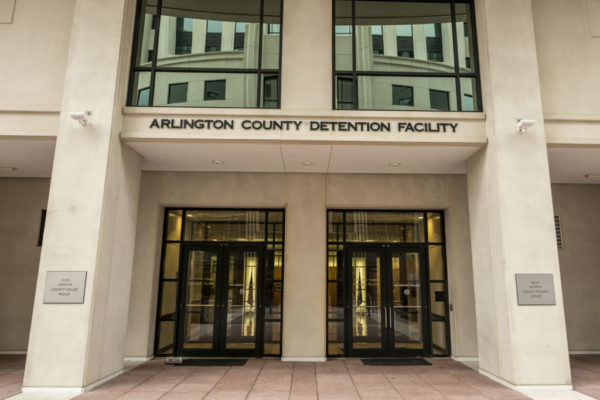
The pickleball craze could be headed to the local jail next.
Acting Sheriff Jose Quiroz, who is one of three vying for the support of local Democrats in the primary this coming Tuesday, said that one amenity he would like to add to the jail is a pickleball court.
In an interview by Arlington Independent Media (AIM), he said the court is “something different” — in addition to the existing basketball court and weight-lifting area in the jail — that deputies and inmates could use. He sees the additional court as a way to improve deputy wellness.
He also intends to add a relaxation room in the jail for deputies and to have wellness conversations with staff, facilitated by local nonprofit Center for Youth and Family Advocacy.
Those two measures are intended to stop the office from bleeding burned-out staff, a pattern in Arlington reflected nationally that sources say appears to be worsening within the Sheriff’s Office, with some deputies actively planning their departures. Already, the vacancy rate stands around 7%, up from a little greater than 3% in 2019, according to the 2024 approved budget.
“Our staffing all around is low,” Quiroz said in the interview. “We have a lot of vacancies.”
He is running against Arlington County police officer James Herring and retired sheriff deputy Wanda Younger. Early voting ends tomorrow (Saturday), while polls open for the Democratic primary on Tuesday. Quiroz’s opponents say they also have ideas for addressing what they say are morale and retention issues in the Arlington County Sheriff’s Office (ACSO).
Herring says the issue stems from deputies being forced to work overtime. They will leave Arlington for jurisdictions with better schedules.
If elected, he intends to advocate for better pay and benefits and, with input from deputies, create more balanced schedules that provide career growth opportunities and mentorship.
“If you can’t hire people faster than people leave your agency, it doesn’t matter how good your recruiting is,” Herring told ARLnow. “Losing a veteran deputy means more than just losing a filled position. It means that you’re losing their years of experience, their ability to mentor younger deputies, and their established connections with those in custody and in the community.”
(Herring’s AIM interview was just posted online this morning.)
He recently picked up endorsements from Abby Raphael, a former Arlington School Board member who also served as an assistant prosecutor, and former independent County Board member John Vihstadt. Both praised his plans for also improving inmate wellbeing.
Younger suggests ending the Sheriff’s unilateral ability to hire and fire deputies without cause. She also suggests relying more on auxiliary deputies — trained civilian volunteers, certified by the state, who sometimes have military or law enforcement experience.
“Hiring is definitely an issue. Retention is a main problem as well,” Younger said in her conversation with AIM. “In order to ensure they remain, we have to increase morale. That’s one area I would focus on.”
Quiroz has the endorsement of several other current and former local and state elected officials, as well as his predecessor, Beth Arthur, who stepped down in January and appointed Quiroz as acting sheriff.
ACSO has tried to tackle the staffing crunch by appointing a sergeant to assist with recruiting — which resulted in more applications processed and a slightly faster hiring window — and budgeting $20,000 in the 2024 budget for recruiting.
The sheriff’s office serves warrants, runs the county jail and provides security at the courthouse, in addition to some other local law and traffic enforcement responsibilities. One impact of the shortages has been fewer deputies providing security in courtrooms and more civilian court security supervisors filling in.
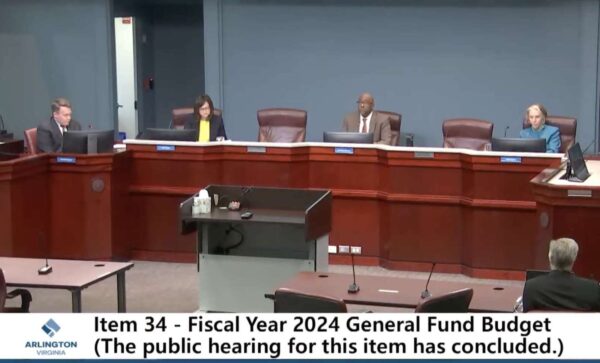
The Arlington County Board has approved a budget that hikes the salaries of county employees — as well as Board members themselves.
The $1.55 billion budget is a 3.3% increase over the current fiscal year’s $1.5 billion budget, funded in large part thanks to rising residential property assessments. The property tax rate was held steady at $1.013 per $100 of assessed value, but the average Arlington homeowner will pay around $450 more per year due to higher assessments and higher fees, including a $98 increase in the trash collection fee and $26 for higher water rates.
As proposed by County Manager Mark Schwartz, the budget will raise the pay of county employees between 4.5 and 10%.
Uniformed police and sheriff’s employees will see raises on the upper end of that scale, amid continued recruiting and staffing challenges among law enforcement agencies. The Board additionally directed Schwartz to consider “any potential enhancements to the newly revised step and grade wage structures that would address compensation, recruitment, retention and pay compression challenges facing police and fire staff.”
Another addition to the budget made by the Board, as voted on during a recent work session, was to hike its own pay.
Following a $20,000 raise of Board salaries last year, the new budget adds just over $62,000 to bring Board salaries to the maximum rate set by the Board in a 2019 vote: $89,851 for members, $95,734 for the Board Chair (a position that rotates among members annually).
The Board pay increase was proposed by Libby Garvey, who said it will provide “close to a living wage for people doing this job, commensurate with the time and the skills needed.”
“There is never a good time to raise Board salaries, they’ve always been low,” she said at the work session. “So I would like to do it now.”
Takis Karantonis concurred, noting the cost of living in Arlington.
“We cannot have it so that those that bring a lot of means… are able to afford to run” for office, he said. “That is not in the long-term… interest [of the county].”
Board Chair Christian Dorsey abstained from the vote and Katie Cristol voted against it. Both are not seeking reelection this year.
Two significant focuses of the budget and Board directives were aimed at affordable housing and the opioid crisis.
The budget adds four behavioral health therapists to address substance abuse among students, while providing $95,000 to the Dept. of Parks and Recreation for improved out-of-school youth programming.
The latter was hailed by the Arlington County Council of PTAs.
“Our existing programming was well-intentioned but difficult to access by the students who might need it the most,” CCPTA President Claire Noakes said in a statement. “Not all families are fortunate enough to have an adult tackle the multiple organizational tasks needed to pre-register a child for a class, organize a family calendar, arrange for transportation at a set time each week, and find a way to pay for it. Additionally, students who are dealing with anxiety or depression may not be able to participate in programs that involve physical competition, such as sports.”
“Other students may just need a safe place to decompress when household stress becomes overwhelming,” Noakes added. “We realized that there was an unmet need for accessible, supervised, drop-in space for youth to simply hang out and connect with peers, mentors, and caring adults.”
The budget, as adopted by the Board, includes $83 million for various housing programs. On the heels of the Board’s approval of “Missing Middle” zoning changes — also dubbed Expanded Housing Options — the budget directs the County Manager to design an “Affordable EHO Homeownership Pilot Program” that could be implemented by the end of 2024.
More on the new budget and its approval is below, from a county press release.
The Arlington County Board voted unanimously Saturday, April 22, 2023, to adopt a $1.55 billion balanced Budget for Fiscal Year 2024. The adopted budget focuses on community needs as the County continues to emerge from the pandemic, including affordable housing, while also providing foundational services, such as public safety, environmental services, transportation, and schools.
The base real estate tax rate remains unchanged at $1.013 per $100 of assessed value.
“As we return to normalcy after years of prioritizing critical operations and making difficult budget decisions during the COVID-19 pandemic, Arlington is finally in a position to build much-needed capacity within its departments and in its efforts to address community priorities and needs,” said Arlington County Board Chair Christian Dorsey. “The past few years impacted everyone, especially our lower-income neighbors. Adding funding to the Affordable Housing Investment Fund, for example, ensures that we maintain our vital role in financing affordable housing development within Arlington. Moreover, the County Board is eager to capitalize on opportunities that may arise from the Homeownership Study, helping us further understand how to better support existing and aspiring homeowners.”

An Arlington program that lets emergency patients opt to be taken to an urgent care has only been used about a dozen times since its launch two years ago.
In April 2021, the Arlington County Fire Department implemented a new EMS model referred to as Emergency Triage, Treat, and Transport (ET3) at the behest of the Arlington County Board.
Among the changes from standard practice, the model allows patients the option to be transported to a local urgent care or specialized medical office as opposed to a hospital emergency rooms if emergency personnel deem it appropriate.
“Comparison studies show that treatment at urgent care centers can be up to 50 percent less than the cost of the same care at conventional hospitals for appropriate medical conditions,” noted a county press release at the time.
Another hope-for benefit was taking some pressure off overwhelmed local emergency rooms at the height of the pandemic.
However, in the approximately two years since it was launched countywide, only “roughly a dozen individuals” have been transported to an alternative destination, ACFD spokesperson Capt. Nate Hiner tells ARLnow.
It’s unclear why that number is so low, considering the volume of calls ACFD receives and the fact that Covid hospitalizations continued to significantly increase for nearly a year after the program’s launch.
“I want to highlight that we have offered transport to an alternative destination more than a dozen times,” Hiner said when asked to clarify that data point. “However, if a patient declines that service, the result is a transport to the hospital.”
In December 2021, ACFD launched the second phase of the ET3 program, which allowed a local patient to use telehealth technology to speak with a healthcare professional as opposed to traveling for the appointment.
The “Treatment in Place” service has been used considerably more than the transport to an alternate care facility, though it is still only being used by patients a few times per week.
“Telehealth services have been utilized over 170 times with over 102 individuals successfully treated in place,” Hiner said. “For those who were not treated in place, a wide variety of other final outcomes occurred such as transportation to an alternative destination or self-transport to the Emergency Department.”
In all, Hiner said, the ET3 program has kept “over 100 individuals” from having to go to a local hospital’s emergency department since it was launched two years ago.

With a few minor revisions, the Arlington School Board adopted the superintendent’s budget recommendation as its own proposed budget last week.
Their approval came with the caveat that the $803.7 million budget could change between now and the final approval, which is set for a future School Board meeting on May 11.
The changes last week added more funding for virtual tutoring and uniforms for bus drivers and reduced funding for trailers and a compensation study by a total of $300,000.
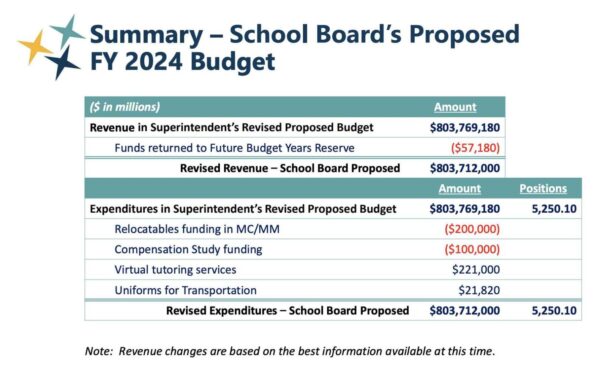
Board Chair Reid Goldstein signaled that members have the next month to smooth over “many items that we were not able to come to a consensus on.”
“In many past years, the School Board’s proposed budget gave a good indication of what the final budget will look like. That may not be the case this year,” he said. “I cannot say there will be radical changes between this proposed and the final on May 11, but I also can’t say there will be minimal changes. I just have to say we are continuing to work on it.”
He is concerned that Superintendent Francisco Durán’s budget relies on $40 million in reserve funds, an emerging trend giving other board members and school staff pause, too.
“Besides the concern that those reserve buckets may not be able to be refilled, there’s the fact that that puts us in a $40 million hole when we start the budget process next year,” Goldstein said.
Next fiscal year, APS could use years of savings from a number of sources, including unfilled positions, to fund cost-of-living adjustments and salary increases for all staff.
Durán told the Arlington County Board on Friday this aligns APS with Gov. Glenn Youngkin’s proposed budget and makes the school system’s compensation scale more competitive with nearby districts.
County Board Chair Christian Dorsey said it is “a reasonable choice to use savings in personnel on personnel that you actually have.”
“I can tell you, anecdotally, [Assistant Superintendent of Finance and Management Services] Leslie Peterson is worried, if that tells you anything,” Board Vice-Chair Cristina Diaz-Torres replied.
“This has been an ongoing discussion for many, many years, in the sense that we have had a habit of needing to use reserves in order to cover for core instruction in the past,” she added, noting the proposal leaves APS with $17 million in reserves “to sustain us for any ongoing overages for next year.”
Durán pointed out more than 55% of the reserves used comes from compensation reserves, which are replenished annually with savings from unfilled positions or new hires, who earn less than the longer-tenured staff they replaced. That money is earmarked for future compensation spending.
“It’s been a practice for us to separate that out and show the public and show our staff that all the money coming from lapse and turnover at closeout is going to be dedicated toward compensation reserves,” he said.

